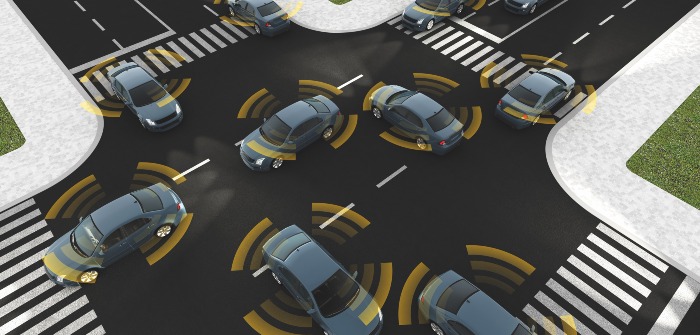
It is evident that vehicular communication is an essential enabler for achieving higher levels of automated driving. However, for a long period, it remained under investigation among the automotive industry players whether the required wireless access should rely on cellular access technology (also known as C-V2X) or on direct access technology (known as DSRC). Here, we demonstrate that future use cases of autonomous driving will require both technologies to be used in coordination or cooperation. State-of-the-art multi-wireless standard devices employ individual modules for different technologies. Therefore, in the absence of any inter-wireless standard interface, realization of such a cooperative system appears to be difficult. We present a recently released single-chip solution for the implementation of a dual-band, dual-wireless standard vehicular communication system. Using the single chip, one can transmit and receive concurrently in multiple bands. While this device is not automotive qualified, the technology used could be leveraged to support automotive manufacturers by providing product differentiation and enhanced control for improved quality of service.
The focus of this article is on the development of vehicular communications (V2X) devices. An overview of V2X application scenarios will be presented along with the two wireless access technologies that could be used to perform V2X communications. With the help of the brief V2X introduction, we will establish an understanding that wireless access for V2X communications controlled by the cellular network (also known as cellular V2X, or C-V2X) could complement other wireless access candidates in unlicensed and dedicated frequency spectrum ranges such as dedicated short-range communication (DSRC) or IEEE 802.11p. For this purpose, it is necessary to link the requirements of the use cases and the need for exploiting the benefits of multiple access technologies. When it comes to the realization of a multistandard V2X device, currently, multiple modules with individual software/firmware implementation could be used. However, this limits the potential of cooperative/coordinated function of the access technologies. The limitations are discussed in the section “Introducing a Single RF IC (ADRV9026) for Future V2X Systems.” The ADRV9026 is a radio frequency transceiver (TRx) in the ADI RadioVerse® portfolio covering the sub-6 GHz frequency range. This multichannel, multiband transceiver technology could enable a multiband V2X communication device.
Vehicular to Everything (V2X) Communications
The automotive world is rapidly innovating to achieve full automation in all possible driving scenarios, maneuvers, and situations. It has been established as a fact that wireless connectivity will be required as one of the fundamental technologies in enabling not only full automation but also lower levels of automation. In particular, safety critical applications of self-driving vehicles will heavily rely on wireless connectivity. It is essential to perform safe maneuvers with ultimate (99.999%) reliability in the presence of entities that share the driving space or traffic system. Such entities may include other vehicles, persons, transport systems on the road, or a traffic management network. Hence it is essential to equip every vehicle with wireless connectivity for the purpose of information exchange, cooperation, and coordination with other entities in the system.
For this purpose, the foundations of automotive intelligent transportation systems (ITS) have been laid by the governing bodies in Europe (for example, ETSI). Similar systems have been developed all over the world, in America and Asia Pacific. ITS has defined and specified communication nodes, architecture, protocols, and messages for a diversity of applications and use cases. New infrastructure is required to enhance the DSRC-based applications in unlicensed or dedicated frequency bands. The infrastructure deployment process is already active in many regions under smart highways and smart cities initiatives. In the case of C-V2X, the existing cellular infrastructure is used. Figure 1 shows the interfaces with which an ITS vehicle can communicate with other vehicles or other entities in the transportation system. The following is a description of each interface:
V2V (Vehicle-to-Vehicle) Communications: Initially it was only for broadcast messages, but now vehicles can also perform unicast or multicast messaging. This interface could be used for any information propagation directly from one vehicle to another in the range of communication—for example, in case of emergency braking.
V2P (Vehicle-to-Pedestrian) Communications: Using this interface, vehicles and roadside users could communicate assuming the smartphone has a V2X application. For example, a vulnerable roadside user could be warned of an approaching vehicle.
V2N/V2I (Vehicle-to-Network or Vehicle-to-Infrastructure) Communications: This interface could be used for any information facilitating smart transportation.
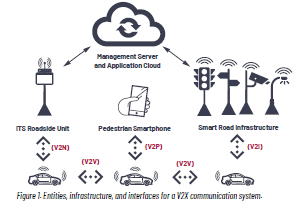
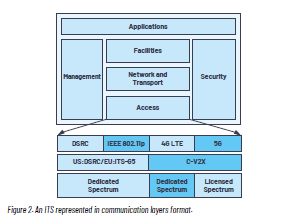
Cellular V2X (C-V2X)
Providing 100% cellular network coverage is a very difficult challenge for any mobile network operator. On the other hand, a radio coverage hole could be worse than a street hole for connected and automated driving. Therefore, C-V2X has provisioned enhanced features by which it can also work in the absence of network coverage. In Figure 3a, a scenario is shown where vehicles are communicating in the presence of network coverage. There are two options for the vehicles to communicate:
Option 1 is by using the classical Uu interface (named by 3GPP for the radio link between the end user device and the radio base station) where the cellular network is involved between two communicating V2X nodes.
Option 2 is by using a new interface known as PC5, which offers direct communication between the V2X nodes. It is also known as sidelink (SL) communication.
The network coverage is absent in Figure 3b. However, using the PC5 interface, the V2X nodes can still communicate. Under the coverage scenario, the network can use any allocated cellular band. The next section addresses what band will be used without network coverage.
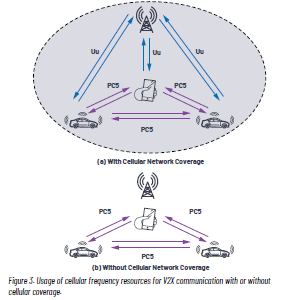
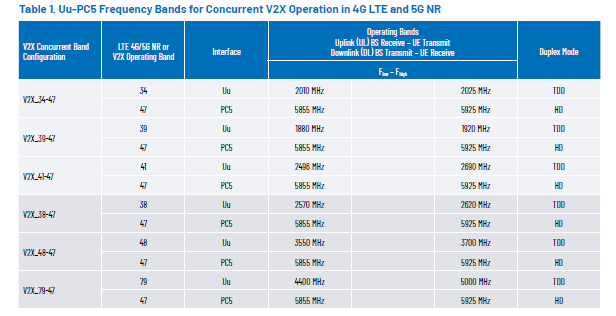
V2X Spectrum Allocation
A dedicated spectrum with a bandwidth of 70 MHz has been allocated in Europe for the purpose of vehicular communications in the 5.9 GHz band.4 The efforts are underway to allocate it globally. Moreover, harmonization work is in process to enable the use of ITS-G5 and C-V2X in this band. In the context of C-V2X, the service could already use multiple cellular bands together with the combination of PC5 and Uu interface. The cellular standard is investigating the concurrent operation of dual bands for V2X. Based on 3GPP specifications,5,6 we have created Table 1 to summarize some example combinations of bands for concurrent operation of V2X service, using 4G LTE and the 5G New Radio (5G NR) interface cellular radio access technologies respectively. Highlighted rows are exclusive only for 5G NR.
Dual-Band and Dual-RAT V2X Systems
In the presence of multiple radio access technologies (RATs) and the possibility of communication in multiple spectrum bands, automotive OEMs must decide what to adopt. In the U.S., the FCC is inclined (at the time of writing this article) toward the use of DSRC-based wireless access,7,8 whereas the Asia-Pacific region is welcoming the development and deployment of C-V2X.9 In Europe, the idea is to keep the wireless access technology neutral.10 In this regard, some studies have been presented that outline the benefits of ITS-G5/DSRC over C-V2X. Similar studies argue for the benefit of C-V2X over ITS-G5. Hence, automotive and telecom industry partners are working to develop a solution where V2X service can exploit the benefits offered by wireless access technologies in the licensed as well as unlicensed spectrum.11
Figure 4 is a modified version of Figure 2 where we have elaborated the access layer by introducing a new sublayer between the radio access and packet access. We call it wireless access management (WAM). The function of this sublayer is to ensure the optimized V2X service delivery from the network to the radio level. Based on use case (latency requirements, QoS, etc.), traffic (congestion) and link (radio quality) conditions, it could select different wireless access technologies in coordination (diversity) or in cooperation (higher throughput). For example, if congestion is detected on the ITS-G5 air interface, then the same message could be sent over PC5 using C-V2X. This will provide diversity gain and ensure reliability. In a use case where vehicles are exchanging high density map data, the Uu interface could be used in cooperation with PC5 or ITS-G5 in order to fulfill the required high throughput.
IEEE contributions12,13 present and discuss the benefits of similar concepts, as shown in Figure 4, in great detail with the help of analytical as well as simulation methods. As described previously using Table 1, within the C-V2X framework, cellular systems standardization bodies are already investigating the concurrent operations of 4G LTE Uu and
5G NR Uu bands with PC5 and ITS-G5 in the 5.9 GHz band. Hence, with the concurrent operation of bands and concepts previously explained, we can state that the foundations for a dual-band and even dual-RAT V2X system have been laid by the standardization bodies and the applied industrial research community. Now it is time for the automotive industry to discover the optimum hardware implementations by which they can exploit the benefits of dual-band and dual-RAT V2X concepts.
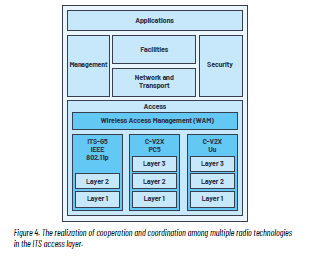
Introducing a Single RF IC (ADRV9026) for Future V2X Systems
Present-day wireless devices are already equipped with multiple wireless standards where each standard is implemented using its unique module or piece of hardware. Mostly these modules provide a solution from the RF level to the application layer. Implementing such a dual-band V2X system and providing a coordination and cooperation mechanism is not easy in such architectures, as the manufacturers or vendors of such modules do not provide the degrees of freedom to access the intermediate layers, which is necessary to implement coordination or cooperation among multiple standards. External standardized interfaces will be required to realize these implementations using available wireless modules.
Hence, we need a design that will allow the implementation of such a system. The design of radio transmitters and receivers using software-defined radios (SDRs) provide us full degrees of freedom in accessing and processing digital data on any stage. The ADI RadioVerse portfolio includes many wideband radio transceivers that transform RF into bits and bits into RF. This conversion of signal to (or from) the RF band and baseband is based on zero intermediate frequency (ZIF) architecture. Fundamentally, it requires much lower power compared to the conversion based on direct RF sampling, as all the circuits operate at a much narrower bandwidth. Moreover, it facilitates a much simpler and lower cost RF front end as ZIF relaxes filtering requirements on both transmitter and receiver.
The ADRV9026 is a recent expansion of the RadioVerse portfolio in the dimension of dual-band SDRs. It is a single-chip, fully integrated RF IC. It has four transmit and four receive channels, which can be programmed and controlled independently to transmit and receive any carrier frequency between 75 MHz and 6 GHz. The receive bandwidth is up to a maximum of 200 MHz, whereas transmitter synthesis bandwidth is up to a maximum of 450 MHz. On-chip observation paths, each with a bandwidth of up to 450 MHz, are also present to support the linearization of power amplifiers in high power transmission scenarios. A functional block diagram of the whole transceiver is presented in Figure 5.
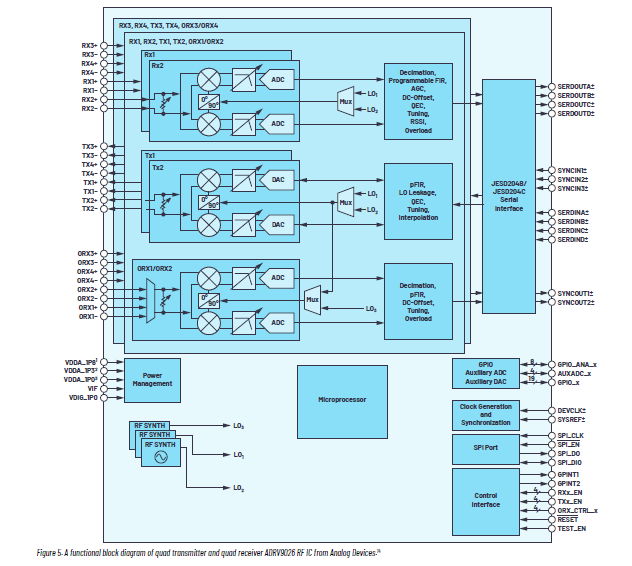
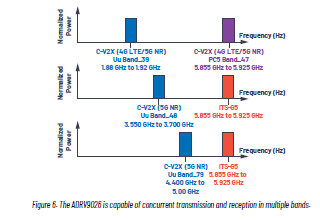
Using the advanced local oscillator architecture, the ADRV9026 can transmit and receive simultaneously in multiple frequency bands below 6 GHz. Figure 6 shows an example of concurrent transmission and reception in different bands or different wireless access using a single RF IC ADRV9026. Here we have selected three combinations of bands only. We emphasize that the ADRV9026 is capable of performing in any band between 75 MHz and 6 GHz. Due to the presence of four independent RF channels in the ADRV9026, we can even realize a 2 × 2 MIMO feature for each individual band or technology. We see multifold gains when using the ADRV9026.
- We can flexibly select any band within C-V2X, and this flexibility comes without an extra certification cost.
- Using multiple RATs in cooperation will require higher synchronization. Achieving this synchronization with the ADRV9026 will be simpler, as both bands are controlled by the single RF IC. In the section “Dual-Band and Dual-RAT V2X Systems,” we have discussed the concepts for a dual-band V2X system and how a single RF IC can be used for this purpose. In the future, we will present a bit more detail about the architecture and design of such a dual-band V2X device.
- With the ADRV9026, RF-to-bits conversion could be performed very close to the antenna. This can avoid the RF signal losses in coaxial cables, which are quite higher in 5.9 GHz V2X bands.
- When it comes to RF performance, the ADRV9026 fulfills wireless base station requirements. The existing wireless modules are based on ASICs, which are developed for end user equipment. Hence, the ADRV9026 delivers higher RF performance, which implies lower latency, higher reliability, and higher QoS. All these metrics then provide higher data rates and over-the-air throughput, which converts to enhanced driving and passenger experience with higher safety.
- With higher data rates and lower latency, safety related use cases are better supported as they provide shorter reaction times to the drivers or autonomous driving systems. For example, in a heavy traffic scenario where unlicensed/dedicated radio resources are reaching their congestion limits, a cooperative/coordinated system, as presented in “Dual-Band and Dual-RAT V2X Systems,” can provide higher reliability and better safety standards as compared to a standalone or single access system.
Hence, it is essential to meet the requirements of V2X use cases using a cooperative/coordinated implementation with cognitive intelligence and support of a single RF IC. Analog Devices has the technology to achieve this on a single device, such as the ADRV9026.
Conclusion
In this article we have presented an account of the current development of V2X communications, which is an essential enabler for autonomous driving vehicles. In this space there are two wireless technologies that could complement each other to fulfill the critical requirements of V2X service. The two technologies are C-V2X and DSRC/ITS-G5, which are operable in licensed and unlicensed bands. There are different options for the realization of a coordinated/cooperative V2X system. Analog Devices has the technology to support dual-band and dual-wireless standards with higher RF performance, lower latency, higher data rate, and higher reliability. We have discussed how we can design a V2X communication device using this RF IC, which could provide wireless access concurrently to the two V2X technologies in two different radio bands. In the next article, we will dive deeper into how an ADRV9026-based design can be used to demonstrate support for multiband V2X communication.
References
- ETSI TS 102 894-1 V1.1.1 (2013-08): Intelligent Transport Systems (ITS); Users and Applications Requirements; Part 1: Facility Layer Structure, Functional Requirements and Specifications. ETSI, August 2013.
- Khadige Abboud, Hassan Aboubakr Omar, and Weihua Zhuang. “Interworking of DSRC and Cellular Network Technologies for V2X Communications: A Survey.” IEEE Transactions on Vehicular Technology, Vol. 65, No. 12, December 2016.
- 3GPP TS 36.300 V15.7.0 (2019-09): 3rd Generation Partnership Project; Technical Specification Group Radio Access Network; Evolved Universal Terrestrial Radio Access (E-UTRA) and Evolved Universal Terrestrial Radio Access Network (E-UTRAN); Overall description; Stage 2 (Release 15).
- ETSI EN 302 571 V2.1.1 (2017-02) Intelligent Transport Systems (ITS);
- Radiocommunications Equipment Operating in the 5 855 MHz to 5 925 MHz Frequency Band; Harmonised Standard Covering the Essential Requirements of Article 3.2 of Directive 2014/53/EU. ETSI, February 2017.
- 3GPP TR 36.786 V14.0.0 (2017-03) Vehicle-to-Everything (V2X) Services Based on LTE; User Equipment (UE) Radio Transmission and Reception.
- 3GPP TR 38.886 V0.5.0 (2020-02) V2X Services Based on NR; User Equipment (UE) Radio Transmission and Reception.
- Fact Sheet—Use of the 5.850-5.925 GHz Band: Notice of Proposed Rulemaking— ET Docket No. 19-138. Federal Communications Commission. November 2019.
- Dedicated Short Range Communications (DSRC) Service: Rule Part 47 C.F.R, Parts 90 and 95. Federal Communications Commission. April 2019.
- ITS Spectrum Utilization in the Asia Pacific Region. 5G Automotive Association.
- Position Paper: Europe’s Leadership in Connected and Automated Driving Depends on Technology-Neutral, Innovation-Oriented Policies. 5G Automotive Association. November 2018.
- 5G Solutions for Future Connected Mobility. 5G NetMobil.
- Richard Jacob, Norman Franchi, and Gerhard Fettweis. “Hybrid V2X Communications: Multi-RAT as Enabler for Connected Autonomous Driving.” 2018 IEEE 29th Annual International Symposium on Personal, Indoor and Mobile Radio Communications (PIMRC), September 2018.
- Richard Jacob, Waqar Anwar, Gerhard Fettweis, and Joshwa Pohlmann. “Exploiting Multi-RAT Diversity in Vehicular Ad-Hoc Networks to Improve Reliability of Cooperative Automated Driving Applications.” 2019 IEEE 90th Vehicular Technology Conference (VTC2019-Fall), September 2019.
- ADRV9026 Data Sheet. Analog Devices, Inc., January 2021






